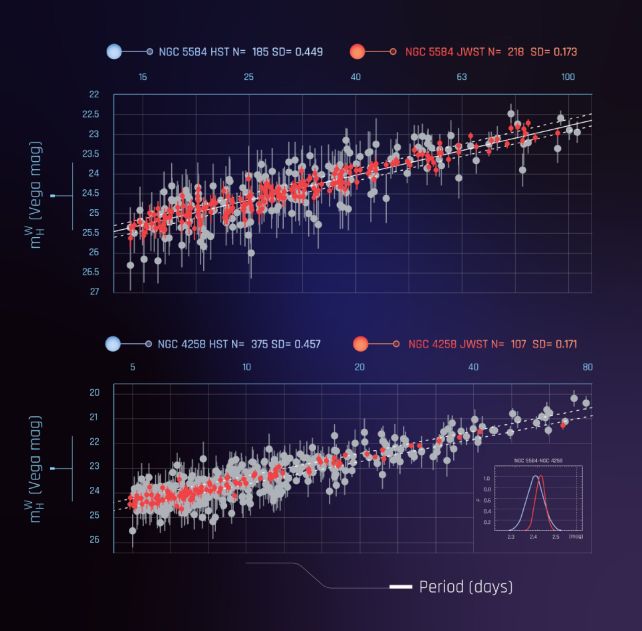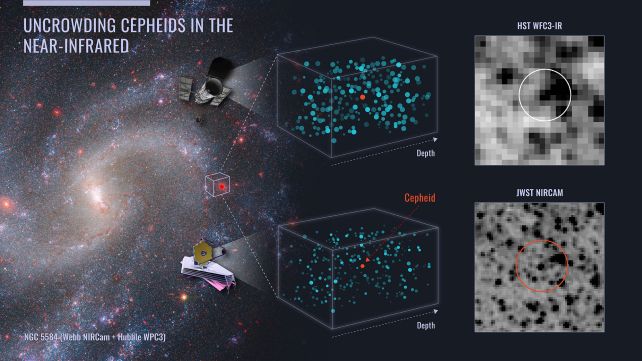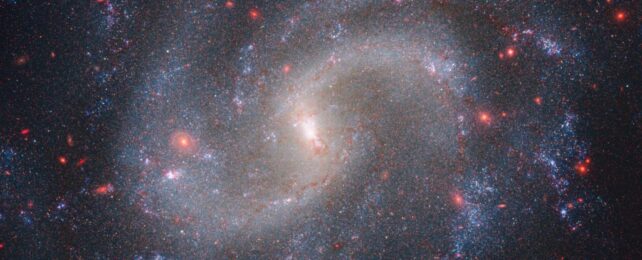The James Webb Space Telescope has measured the expansion rate of the Universe, and the results are not great news for the biggest crisis in cosmology.
The finding is in agreement with measurements made by the Hubble Space Telescope. This means that there's no error in the Hubble data, and we're still at an impasse.
A disagreement between different measurement methods known as the Hubble tension remains intact – so we're going to have to rely on some other way of figuring out how fast our Universe is expanding.
The Universe around us may appear unchanging, but everything we see is actually moving away at a tremendous rate known as the Hubble Constant, or H0. It's unclear how fast H0, precisely – because different ways of measuring it return different results.
One way is by looking at relics of the early Universe, such as leftover light in the cosmic microwave background, or acoustic waves frozen in time.
Another way is by measuring the distances to objects with known intrinsic brightness, such as Type Ia supernovae, or Cepheid variable stars, the light of which fluctuates with a regularity that is linked to their intrinsic brightness.

The first method tends to return an expansion rate of around 67 kilometers per second per megaparsec. The second, around 73 kilometers per second per megaparsec. The discrepancy between the two is known as the Hubble tension.
These measurements have been performed repeatedly, dramatically reducing the chances of error for each of the estimates. Yet the possibility remains that there's something misleading about at least some of the data – especially because some of the best data we have on Cepheid variables comes from a single source, the Hubble Space Telescope.
"[Cepheid variables] are the gold standard tool for the purpose of measuring the distances of galaxies a hundred million or more light years away, a crucial step to determine the Hubble constant. Unfortunately, stars in galaxies are crowded together in a small space from our distant vantage point and so we often lack the resolution to separate them from their line-of-sight neighbors," explains astrophysicist Adam Riess of the Space Telescope Science Institute (STScI) and Johns Hopkins University.
"A major justification for building the Hubble Space Telescope was to solve this problem… Hubble has better visible-wavelength resolution than any ground-based telescope because it sits above the blurring effects of Earth's atmosphere. As a result, it can identify individual Cepheid variables in galaxies that are more than a hundred million light-years away and measure the time interval over which they change their brightness."
In order to cut through any dust that obscures light closer to the optical these observations need to be conducted in near-infrared, a part of the electromagnetic spectrum Hubble isn't particularly strong in. This means that there remained some uncertainty about the data it obtained.
JWST, on the other hand, is a powerful infrared telescope, and any data it collects is not subject to the same limitations.

Riess and his team first turned JWST to a galaxy with a known distance, to calibrate the telescope for the luminosity of Cepheid variables. They then observed Cepheids in other galaxies. In total, JWST collected observations of 320 Cepheids – dramatically reducing the noise found in the Hubble observations.
In spite of the Hubble data being so noisy, the data for determining distances was still in agreement with the JWST's observations. This means we can't rule out calculations of H0 based on Hubble data; 73 kilometers per second per megaparsec is sticking around for the time being, and human error – at least in this case – can't account for the Hubble tension.
We still don't know what is causing the tension. One of the leading candidates is dark energy – a mysterious, unidentified yet seemingly fundamental force that appears to exert negative pressure that's accelerating the Universe's expansion. With the new JWST measurements, we may be just a little closer to an answer.
"With Webb confirming the measurements from Hubble, the Webb measurements provide the strongest evidence yet that systematic errors in Hubble's Cepheid photometry do not play a significant role in the present Hubble tension," Riess says.
"As a result, the more interesting possibilities remain on the table and the mystery of the tension deepens."
The results have been accepted into The Astrophysical Journal, and are available on arXiv.
